Fluids and Solids Handling
Media Extends Filter Lifespan in Medium- to High-Volume Operations

The vertical cartridge filter (VCF) removes dust from medium to large volumes of air. An easy-to-use cartridge clamp system simplifies filter media replacement, minimizing maintenance time and reducing overall operating costs. The filter is equipped with a smart timer, which includes a sensor that reads the pressure drop across the filter elements. This ensures timely cleaning, thereby reducing compressed air consumption and lengthening cartridge life. A radial inlet allows for excellent material separation during moderate-air-volume applications. An optional high-entry inlet with a pre-separation chamber optimizes performance in high-volume systems; the chamber removes the largest powder particles, safeguarding the media from pollutants and extending the media life. Each unit is constructed of reinforced carbon steel that is rated for 6.5 psi.
Schenck Process

Heavy-Duty Blender Minimizes Residue
The Model HD-510-MS paddle blender is equipped with four high-speed choppers that break lumps and/or disperse dry bulk solids, pastes, slurries, and emulsions containing agglomerates. It handles free-flowing and non-free-flowing materials, such as cohesive/adhesive or wet powders, in batch volumes up to 200 ft3 (5.7 m3). Built for demanding applications, the blender features a heavy-gauge carbon steel U-shaped vessel. The tight tolerance of 1/16 in. to 1/8 in. (1.6–3.2 mm) between the outer paddle edges and the trough wall minimizes the amount of material remaining in the vessel after discharge of blended batches. The paddles project radially from the main shaft, which is flange-mounted for simple maintenance. The shaft is powered by a 75 hp (56 kW) motor and each of the high-speed tulip-style choppers is driven by a 7.5-hp (5.6-kW) motor. The blender is equipped with hinged and gasketed cover sections and a removable safety grating with safety interlocks.
Munson Machinery Company, Inc.

Silicone Tubing Meets Pharmaceutical Industry Standards
The AdvantaSil line of silicone tubing now includes an ultralow-temperature formulation suitable for applications related to bulk drug storage and transport. The tubing remains flexible and crush resistant at temperatures down to –112°C (–169.6°F) without any cracking or loss of integrity. In addition, it is fully functional up to 175°C (347°F). The material meets U.S. Pharmacopeia (USP) Class VI, International Organization for Standardization (ISO) 10993, and European Pharmacopoeia (EP) 3.1.9 standards, as well as U.S. Food and Drug Administration (FDA) requirements set forth in the Code of Federal Regulations 21 CFR 177.2600. It allows for optimal freezer utilization since no clam shell is needed to protect the tubing. Engineered for single-use applications, it can be sterilized by autoclave or gamma irradiation. All assembly and final packaging are performed in an ISO Class 7 cleanroom. The tubing is available as molded manifold tubing assemblies, BioClosure container closures with tubing, or as part of a bag assembly.
AdvantaPure
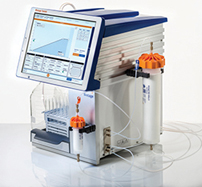
Flash Purification System Features New Columns that Reduce Solvent Use
The Biotage Selekt flash purification system boasts high-flowrate and high-pressure capabilities that enable fast separation. The purification system is compact and has a small bench-top footprint. It utilizes the company’s new Sfär columns, which can be mounted either on the side or on the front of the instrument and contain high-surface-area spherical silica with a high loading capacity. This allows operators to select a smaller column to perform a given separation, reducing both the amount of solvent used and the cost of the separation. The columns can be liquid- or dry-loaded, opened, and used in conjunction with the company’s Samplet cartridges for optimum chromatography. Various media are available, ranging from 5 g to 350 g sizes. The system features a large touch-screen interface, and the intuitive controls are easy to use for operators of all skill levels.
Biotage
Material Separator Reduces Water Consumption
The gravitational-inertial classifier (GIC) air classifying system automatically separates dry materials without using water. This replaces the traditional wet separation processes that often consume millions of gallons of water daily and reduces operating costs, streamlines operations, and eliminates the need for settling ponds. The pneumatic air classifier harnesses gravitational, inertial, centrifugal, and aerodynamic forces simultaneously to separate particles at any cut point from 63 μm to 300 μm (50 to 230 mesh). The proprietary, heart-shaped design passes a current of air through a curtain of falling material, and the air directs each particle toward a series of vanes. Coarse particles are discharged while entrained fine particles are recirculated in an eddy current until they are discharged and captured by a dust collector. The system contains no moving parts, which virtually eliminates maintenance requirements and permits unattended, continuous operation. The device is suitable for classifying sand, crushed stone, cement, salt, lime, soda ash, and a variety of aggregates and minerals.
Van Tongeren America, LLC
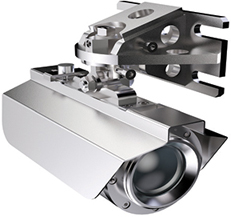
Environmental, Health, and Safety
Methane Detector Operates in Hazardous Environments
The Senscient ELDS open-path gas detector provides reliable methane monitoring with no false alarms. It is typically placed around the perimeter of a plant, in process and storage areas, or near equipment that poses a risk of gas leaks, such as compressors, pumps, pressure reducers, valves, and pipe flanges. The instrument is methane-specific with a 0–1 lower flammable limit-meter (LFL-m) measuring range; the conventional 0–5 LFL-m measuring range is available as an option. A laser scans a narrow infrared absorption range where there is no corresponding absorption from water vapor to minimize the effects of fog, rain, and snow. The detector has FM 6325 performance approval and is certified for operation in Class I, Div. 1 and Class I, Zone 1 environments. SimuGas, a built-in automatic daily functional test, eliminates the need for site technicians to enter potentially hazardous areas to conduct routine tests. The detector is available in three path lengths: 16–131 ft (5–40 m), 131–394 ft (40–120 m), or 394–656 ft (120–200 m), all of which have a fast response time of less than 3 sec. This detector is suitable for use in oil and gas production, refining, terminal and tank storage, chemical manufacturing, and electric power generation facilities.
MSA
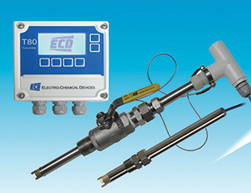
Cyanide Monitor Detects Wastewater Hazards
The S80-T80 cyanide analyzer helps to ensure that cyanide levels in a plant’s wastewater effluent comply with local, state, and federal regulatory limits. The CN– ion electrode combines a silver-cyanide/silver-sulfide (AgCN/AgS) solid-state crystal sensing element and a double-junction reference electrode. The sensors are used with the Model T80 transmitter to measure CN– concentrations from 0.2 ppm to 260 ppm. The CN– ion-selective electrode cartridge develops a potential proportional to the concentration of free CN– ions in the stream being monitored and produces an output ranging from 54 mV to 60 mV per decade of change in concentration. Sensor response time varies from a few seconds in concentrated solutions up to a few minutes for concentrations in the lower-ppm ranges. The retractable device is designed with a 1-in. MNPT ball valve, a 1-in. by 0.75-in. reducer, a 0.75-in. MNPT compression fitting to create the process connection, and a variable insertion length that allows installation in pipe tees, in flow cells, or through tank walls. The sensor is available with 4–20-mA output with MODBUS RTU on 24-VDC and 110/220-VAC instruments. The transmitter can be configured with HART 7 communications and an optional three-alarm relay.
Electrochemical Devices
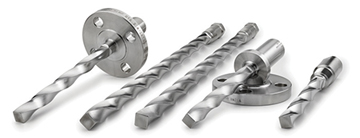
Instrumentation
Thermowells Reduce Fatigue Failure in Challenging Process Conditions
Rosemount Twisted Square thermowells reduce dynamic stress, simplify process calculations, and permit more accurate temperature measurements. These shorter and/or larger-diameter thermowells minimize vortex-induced vibration (VIV), which can reduce accuracy and/or slow response times. This new thermowell design improves reliability and reduces the risk of fatigue failure by dampening dynamic stresses caused by oscillating vortex pressures (the primary source of thermowell stress failures). The design reduces VIV by more than 90%. The thermowell design complies with the ASME PTC 19.3 TW standard for safety and reliability, and is suitable for applications that require thermowells to withstand harsh or changing process conditions.
Emerson
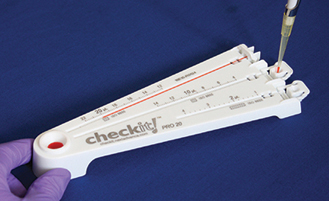
Simple Device Verifies Pipette Accuracy
Checkit provides an economical, fast, and easy way to verify pipette accuracy. Testing can be performed on a laboratory bench, under the same conditions as the experiment, and can confirm proper functioning after a pipette has been dropped, cleaned, or borrowed. Its easy-to-read volume markings make it unnecessary to read a tiny droplet’s weight on a high-precision balance and virtually eliminate evaporative error. The measurement kit meets ISO 8655 calibration standards and comes with three glass capillaries to test the top, middle, and low ranges of the pipette. The testing procedure involves filling the pipette tip with dye, dispensing the dye into the well, flipping up the well tab, and checking the value. The kit is available in seven sizes ranging from 2 µL to 200 µL.
Next Advance, Inc.
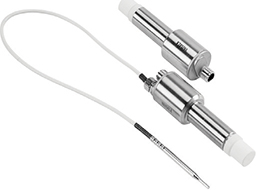
Smart Probes Detect Hydrogen Peroxide Concentration
The new HPP271 and upgraded HPP272 smart probes use the PEROXCAP sensor to measure hydrogen peroxide concentrations. In addition, the HPP272 is able to detect temperature and humidity, operates over a wide temperature range (5°C to 50°C), is able to indicate relative saturation and relative humidity, and now features dew point and vapor pressure measurements as well. Both probes have a compact corrosion-resistant housing with an Ingress Protection (IP)-65 rating. The instruments provide digital and analog outputs and incorporate timesaving onsite calibration through the Insight PC software, which now also logs short-term data for 48 hr.
Vaisala

Portable Calibrator Boasts Fast Cool-Down
The JOFRA CTC-1205 compact temperature calibrator has a range of 100°C to 1,205°C (212°F to 2,201°F), accuracy of 0.2°C (0.36°F), and stability of 0.1°C (0.18°F) over the entire temperature range. It has cool-down times as low as 45 min, which saves working hours and improves workflow. Mains Variance Immunity (MVI) circuitry ensures stability despite variations in the power mains. The instrument boasts an intuitive, easy-to-use interface and popular functions such as automatic switch testing and automatic stepping. The calibrator is rugged, lightweight, and designed for laboratory and in-plant use. An optional carrying case improves portability and safety when the calibrator is moved from one location to another. The case stores and protects the CTC-1205 calibrator, the reference sensor, inserts, support rods, wires, manual, plugs, and insert tools all together. This sensor is suitable for waste incineration, electric power generation plants, and oil and gas production applications.
Ametek

Flow Sensor Options Expand Measurement Capabilities
The EPS magnetic-inductive flow sensor can measure the volumetric flow of liquids, slurries, pastes, and other electrically conductive media. It can measure flowrates from 0.5 m/sec to 10 m/sec with an accuracy of 0.3% of the measured value. The volume measurements are unaffected by pressure, temperature, density, and viscosity. The sensor is lined with hard or soft rubber, ethylene propylene diene monomer (EPDM), polytetrafluoroethylene (PTFE), or ceramic, and can withstand a maximum pressure of 580 psig and a maximum temperature of 300°F. A large selection of process connections allows the device to be used in harsh environments. Options for flange fittings include 0.5-in. national pipe thread (NPT), and 0.5–24-in. American National Standards Institute (ANSI) fittings. The electrodes are made from stainless steel, Hastelloy, tantalum, platinum-iridium, or titanium. The instrument has an Ingress Protection (IP)-67 or IP-68 rating against dust and water. Multipoint flowmeters support continuous-airflow heating, ventilation, and air conditioning (HVAC) systems. The EPS sensor is designed for use with the company’s UMF2 transmitter, which is available in a compact or a remote version.
Kobold Instruments, Inc.
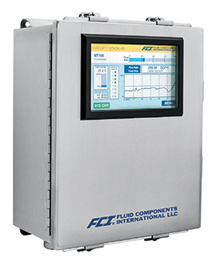
Meters Measure Mass Flowrate and Temperature
MT100 Series multipoint thermal mass flowmeters provide accurate, temperature-compensated direct mass flow measurement of air for highly reliable, proportional integral derivative (PID) control of heating, ventilation, and air conditioning (HVAC) systems. They are available with two to eight air-flowrate sensing points to ensure compatibility with large-diameter piping and large ducts. They have no orifices or glass windows to foul, fog, or clog, making them suitable for use in cold or hot ambient conditions, and in environments with dusty or dirty intake air. The meters measure flowrates from 0.25 to 1,000 ft/sec (0.07 to 305 m/sec) with 100:1 turndown. The temperature-compendated instruments also provide air temperature measurements from –50°F to 850°F (–45°C to 454 °C). The rugged transmitter for this flowmeter has a NEMA 4X/IP64-rated stainless steel enclosure. The transmitter comes with an extensive choice of output options to interface with popular building climate control systems, distributed control systems (DCS), programmable logic controllers (PLCs), supervisory control and data acquisition (SCADA) systems, or recorders. The flowmeters comply with the International Electrotechnical Commission (IEC) safety regulations for electromagnetic compatibility (EMC) and low-voltage directive (LVD), and carry the CE marking. Options are available with FM approval, explosive atmospheres (ATEX), or IECEx agency approvals for Div. II, Zone 2 for process installations containing hazardous, potentially explosive gases and/or dust.
Fluid Components International
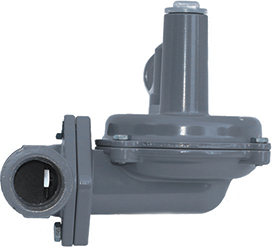
Compact Pressure Regulator is Designed for Heavy-Duty and General Applications
The P140 pressure regulator boasts versatility, accuracy, and a compact design, and is available with or without internal pressure relief. It can deliver pressures of 5 inH2O to 5 psi at temperatures ranging from –20°F to 150°F. Body inlet and outlet sizes include 3/4 in., 1 in., and 1-1/4 in., in a straight or angled body configuration, and with a variety of standard and custom-sized orifices. An iron body, aluminum bonnet, and other components made of stainless and zinc-plated steel and nitrile make the P140 suitable for heavy-duty applications. It is designed for natural gas, liquefied petroleum, air, propane, and general-purpose pressure regulation.
BelGAS

Copyright Permissions
Would you like to reuse content from CEP Magazine? It’s easy to request permission to reuse content. Simply click here to connect instantly to licensing services, where you can choose from a list of options regarding how you would like to reuse the desired content and complete the transaction.
